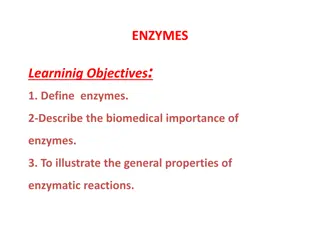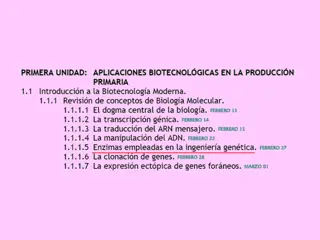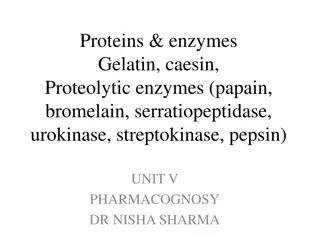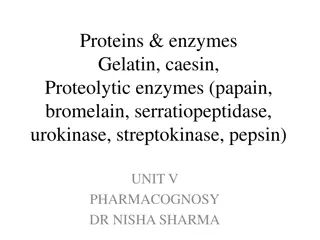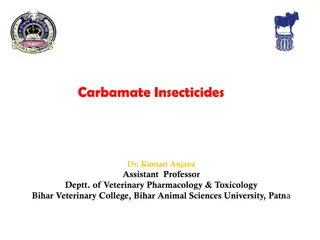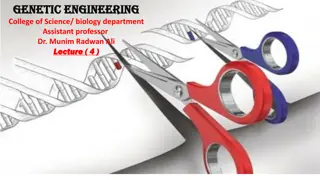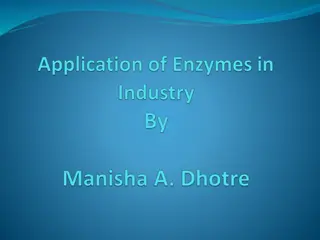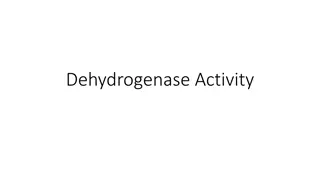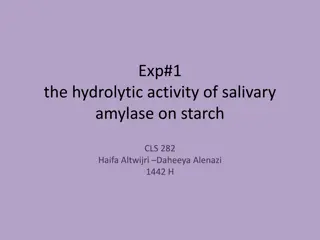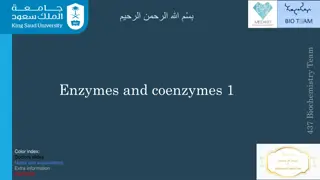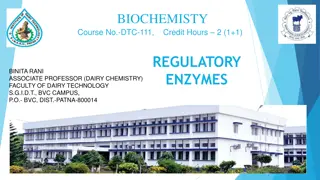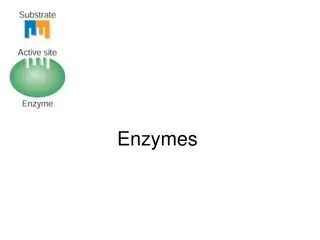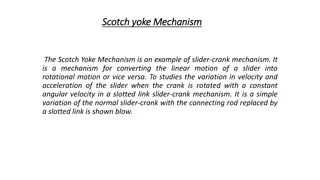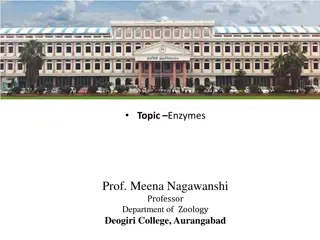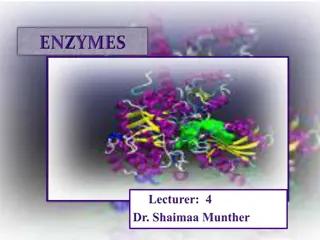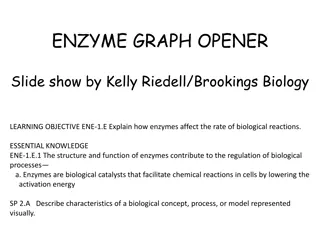Understanding Enzymes: Nature, Classification, and Mechanism of Action
Enzymes are biocatalysts synthesized by living cells. They are protein in nature and specific in their action. This article delves into the definition of enzymes, classification based on enzymatic action, enzyme class reactions, structure, and mechanism of enzyme action, highlighting how enzymes play a crucial role in catalyzing biochemical reactions within biological systems.
Download Presentation

Please find below an Image/Link to download the presentation.
The content on the website is provided AS IS for your information and personal use only. It may not be sold, licensed, or shared on other websites without obtaining consent from the author. Download presentation by click this link. If you encounter any issues during the download, it is possible that the publisher has removed the file from their server.
E N D
Presentation Transcript
Enzymes Pinaki Kr. Rabha
Definition: Enzymes biocatalysts synthesized by living cells. They are protein in nature, colloidal and thermolabile character, and specific in their action. may be define as in
Enzyme class Reaction type Description Catalyze oxygenases, etc. oxidation reduction reaction, e.g., oxidases, dehydrogenases, EC 1 Oxidoreductases Catalyze the transfer or exchange of certain groups among some substrates. Such groups includes amino, carboxyl, carbonyl, methyl, acyl( RC=O) etc. e.g., transaminases, kinases. Phosphorylases, etc. EC 2 Transferases Accelerate the hydrolysis of substrates, cleavage of bonds is accomplished by adding water. e.g., Peptidases, phosphodiesterases, etc EC 3 Hydrolases Catalyzes breaking of C-C, C-O, C-N, C-S and other bonds by means other than hydrolysis or oxidation. E.g., aldolases, decarboxylases, synthases, dehydratases. EC 4 Lyases Facilitate the conversion of isoisomers, geometric isomers or optical isomers. EC 5 Isomerases EC 6 Ligases Catalyze the synthesis of two molecular substrates into one molecular compound with the release energy EC 7 Translocases Catalyze the movement of ions or molecules across membranes or their separation within membranes. E.g., ATP synthase
Structure of enzyme Some enzymes are made up of entirely protein molecules. Such enzymes are called as simple enzyme. In some other cases, in addition to protein part, non-protein part must be associate for enzymatic function. Such enzymes are called conjugate or holoenzyme. The protein part is called apoenzyme, non-protein part is called cofactor. Apoenzyme+ cofactor= holoenzyme Cofactors are again 3 types- Coenzyme-organic matter that are loosely associate to apoenzyme, NAD, NADP, ATP, etc. Prosthetic group- organic substance that are firmly attached to the apoenzyme, e.g., FAD Metal activators- metal ion acts as cofactor, Mg, Fe, Mn, etc.
Mechanism of enzyme action Enzymes are termed as biocatalysts. They catalyze many reactions within the biological system. The mechanism of enzyme action can be explained in the following heads. 1.Enzymes lower activation energy: The energy required by the reactants to undergo the reaction is known as activation energy. The enzymes reduce the activation energy of the reactants, thereby making the reaction go faster at normal temperature.
2.Enzyme- Substrate complex formation: Enzyme action involves the formation of a complex between enzyme and its substrate to form enzyme-substrate complex. This combination brings about by a deformation of some of the bonds of the substrate molecules, thus producing a condition that favours the reaction. E+S ES E+P The ES complex is broken down into products and the enzyme is released.
Lock and key hypothesis- This hypothesis was proposed by Emil Fischer (1884). According to this hypothesis, enzymes have certain active sites with which a substrate molecule can form an intimate association. This association is brought about by random collisions between the enzyme molecule and the substrate molecules. The active sites are specifically shaped within numerous folds of the enzyme molecule. For this reason the enzyme- substrate relationship is often compared to lock & key. As a particular lock can be opened by a particular key, in the same way a particular enzyme acts on a particular substrate. The substrate molecule gets filled upon an enzyme molecule and decomposes into products.
1.Induced-fit hypothesis- This hypothesis was proposed by Koshland (1959). According to this hypothesis, the active site of an enzyme is not pre-shaped to fit the substrate . Rather the substrate molecules can induce a conformational change in the active site of the enzyme. According to Koshland, the active site of enzymes is flexible, not rigid. The configuration of the active site is complementary to that of substrate. The structure of the substrate is also changed during many cases of induced fit, thus allowing a more functional enzyme- substrate complex. Optical rotation measurements and x- ray differentiation analysis of several enzymatic reactions have supported Koshland s hypothesis since enzymes exhibit pronounced conformational change when they bind with their substrate molecules.
FACTORS AFFECTING ENZYME ACTION Enzyme concentration: Increasing enzyme concentration will speed up the reaction, as long as there is substrate available to bind to. Once all of the substrate is bound, the reaction will no longer speed up, since there will be nothing for additional enzymes to bind to.
Substrate concentration: Increasing substrate concentration also increases the rate of reaction to a certain point. Once all of the enzymes have bound, any substrate increase will have no effect on the rate of reaction, as the available enzymes will be saturated and working at their maximum rate.
pH: Each enzyme has an optimum pH range. Changing the pH outside of this range will slow enzyme activity. Extreme pH values can cause enzymes to denature. Each enzyme has a pH value that it works at with maximum efficiency called the optimal pH. If the pH is lower or higher than the optimal pH, the enzyme activity decreases until it stops working. For example, pepsin works at a low pH, i.e., it is highly acidic, while amylase works at a high pH, i.e., it is basic. Most enzymes work at neutral pH 7.4.
Temperature: Raising temperature generally speeds up a reaction, and lowering temperature slows down a reaction. However, extreme high temperatures can cause an enzyme to lose its shape (denature) and stop working. The optimal temperature it occurs when the rate of the reaction is at its highest, each enzyme has a certain temperature at which it is more active, ranges between 37 to 40C .
Activators Effect Activators they enhance the activity of an enzyme. Some of the enzymes require certain inorganic metallic cations, like Mg2+, Mn2+, Zn2+, Ca2+, Co2+, Cu2+, Na+, K+ etc., for their optimum activity. Compounds which are active as prosthetic groups or which provide stabilization of the enzyme s conformation or of the enzyme-substrate complex Rarely, anions are also needed for enzyme activity, e.g. a chloride ion (CI ) for amylase.
Inhibitors effect Enzyme activity is inhibited in various ways. Two of them are: a. Competitive inhibition Occurs when molecules very similar to the substrate molecules bind to the active site and prevent binding of the actual substrate.
Non-competitive inhibition 1. Occurs when an inhibitor binds to the enzyme at a location other than the active site. 2. Inhibitor binding alters the enzyme s three-dimensional configuration and blocks the reaction.
Uncompetitive inhibitor: It occurs when the inhibitor binds reversibly with an ES complex to form an enzyme- inhibitor complex(ESI). ESI is unable to convert to any product. This type of inhibitors ae most effective at high concentration. substrate- substrate






